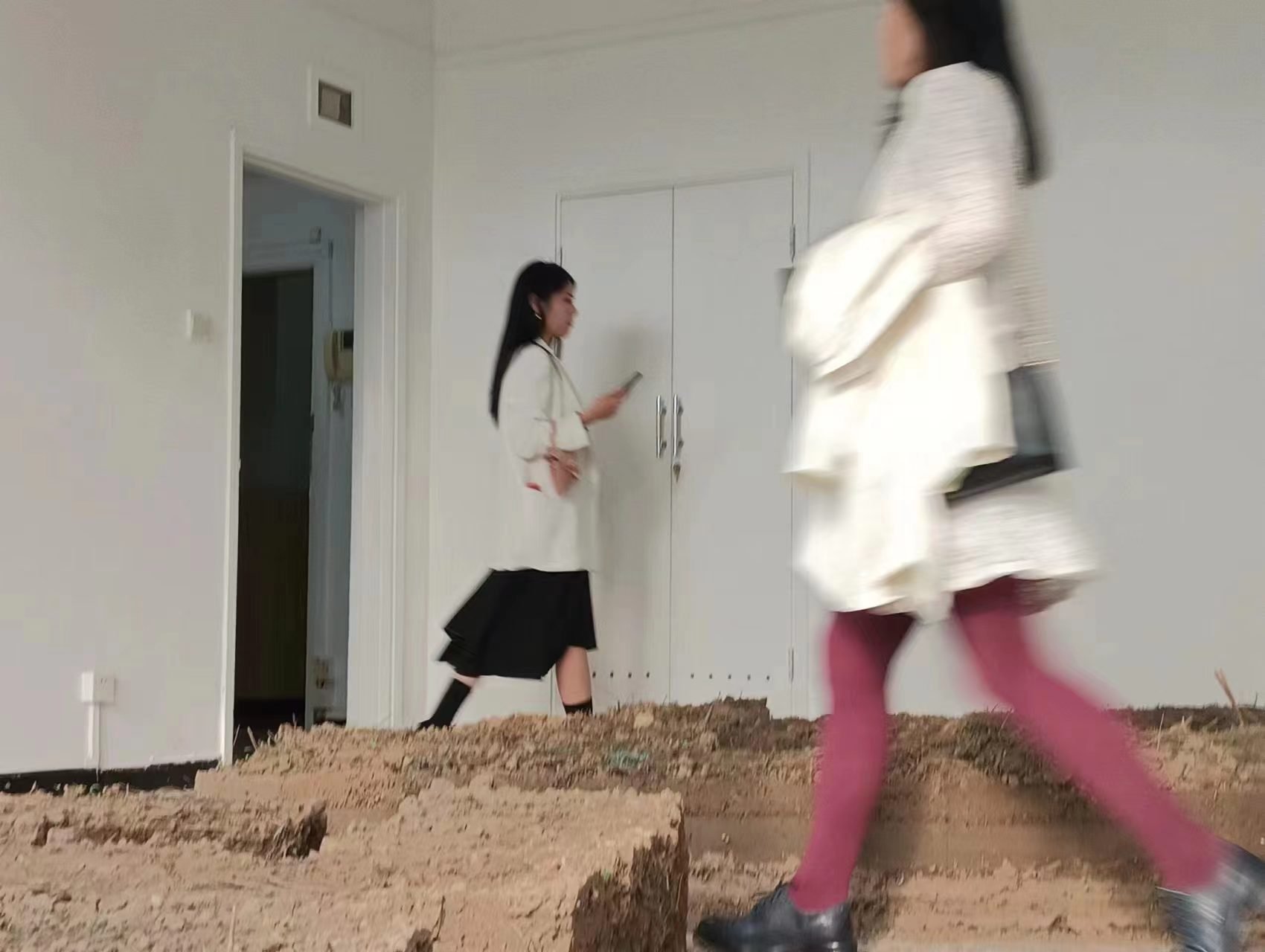In a neglected land, 40.1110 N, 116.6155 E, near the edge of Beijing Capital International Airport Terminal 3, I scooped soil and sculpted two hollow shapes of two Chinese characters, Liu Xia, which means to stay. The shapes are in the same font as used in transportation signage, with two sides of approx. 3 meters and a depth of approx. 0.5 meter. The soil, along with the weeds, roots, and construction waste, were relocated to DRC No. 12. I re-sculpted the soil into two other Chinese characters, Li Kai, which means to leave. The new shapes are in the same font, with two shorter sides of approx. 2.5 meters, and a similar depth of approx. 0.5 meter. As a result of the presence of water and sunlight during the ramming and shaping process, roots and grass seeds germinated. During the 3-month show, the soil will gradually dry up, leaving the fate of the grass uncertain, grow, or wilt.
The shapes in the neglected land are under the flight routes and can be seen from the road a bit far away, responding to the takeoff and landing by either posing a question or constructing variable ambiguous semantic meanings. Whereas in the DRC No. 12 space, the counterpart of the neglected land, the two newly shaped characters, Li Kai, also sway among a question, a subjunctive, an imperative, or a statement. The soil used to be in one word is forged into an opposite word, establishing a semantic contradiction. Sharing identical mass and volume, the soil from the land and that in the space bounds in a same-body connection. The action of reshaping connects the two words, trying to rise above the physical space of DRC No. 12 and the broader social space beyond. Much like the existential question, to leave or to stay, posed by the land, the action of reshaping empowers words-sculpting a social significance.
The wheat grains in the space stand quietly against the vitality radiated from the soil. Some grains are here and there in the sill but the majority are in the cotton sack in the corner. These wheat grains are created over an extended period, as I disassembled a used wooden bedpan, blurring the attribute between organic wheat and inanimate wood. A visual paradox forms as the grains hold “the promise of growing,” yet the compact texture in the wood remains a testament to “its inanimate nature.” The moment when I use the wood pan to produce grains also signals the end of the matter, and the “inorganic” wood connects itself to the grains. The grain is deprived of time but reaps an enduring life in the spatial realm: A texture on the edge of the grain ends the grain as an organic grain but stretches its lifespan in the form of another “seed.”
Binding to the roof inside the space and outside the balcony are several swallow nests made of concrete. The bare rebar is from the demolition construction waste and is in a power battle with the mingled feathers. The earth and root in the beak mirror the concrete and steel. The solidarity asserts both self-protection and encircling. Swallows naturally head back north for winter. When juxtaposing the natural habit of the swallow with the cultural exhortation of humans’ homecoming, I peeked at how people adapt and escape the complexities of social and political landscapes from an instinctive perspective.
A fresh concrete swallow nest sticks to the balcony roof facing the Beijing CBD area. Is it rebuilt after destruction? Or up in the air? Or has it headed elsewhere already?
To stay or to leave is actually a predicament. I buried it in the soil, wrote it in the wood, and hid it in the concrete.
Translated by Bao Xinyi(包昕怡)
2023年4月9号张新军个人项目《别处》在外交公寓12号开展,以下是艺术家关于此项目的自述。
我从北京T3机场边缘处(40.1110 N, 116.6155 E)的一块荒地中,按照交通标识字体——“留下”的笔划为样取土;二字约3米见方,深约0.5米。这些土混杂着荒地表面的枯草与根茎和原有的一些被掩埋的建筑垃圾一起被迁移至外交公寓12号空间内。在公寓空间内,再将这些土重塑为同样字体的“离开”二字,宽约2.5米,高约0.5米。在夯土、塑字过程中使用的水和照进公寓的阳光让这些混杂在土中的根茎和草籽发芽,在为期3个月的展览时间中,这些土会慢慢干裂,新发芽的草会继续生长或慢慢枯萎。
荒地中留下的文字标识位于飞机航线下方,从远处马路上可望见,它与起飞或降落的飞机或形成疑问句式,或构建不断变化着的模糊的语义。而对应荒地的外交公寓12号空间,是土新到达的地方,新塑的“离开”二字,同样摇摆于疑问,虚拟,祈使和陈述之间。土,其自身因为两个词语的反转,形成语义的矛盾;同时,荒地中土的移出和公寓中土的迁入,在质量和体量上等同,形成某种“同身”的关联。重塑这一动作作为两个词语之间的连接,试图冲破外交公寓12号内部的物理空间和公寓外部的社会空间的阻隔,与荒地构成“去留”的存在主义式拷问,赋予词语雕塑一种社会体量。
与土中显现的生机形成对照的是存放在外交公寓12号空间中的麦粒,它们被零星散落在窗台,但大部分被装在墙角处的棉布口袋中。这些麦粒是我经过长期工作,对一块使用过的旧床板进行分解得来,它模糊了麦粒的有机生命属性和木头的物质属性。有机体的麦粒形象产生的“生长预期”与凝固在木头紧凑的纹理中的“不能发芽的事实”形成视觉悖论。而板材被用来加工麦粒时意味着一种物质形态的终止,木材的“无机体存在”寄生于麦粒之中。麦粒被剥夺了时间,却在空间延伸中建立了另一种生命——一条纹理在一颗麦粒的边缘终结,但似乎又在另一粒“种子”中得以绵延。
粘附在公寓内的房顶和阳台处,有几块水泥做的燕巢,裸露的废旧钢筋来源于被拆除的建筑废料,它与掺杂的羽毛形成力量上的对峙。燕子喙中的泥土与草茎,对应于水泥与钢筋,它的坚固既是自我保护又是封锁与围困。在燕子越冬飞回北方的自然习性被赋予归乡与回归故土的文化规劝时,我从燕子的生物本能去看待人在社会环境和政治现实中的适应与逃逸。
在朝向北京CBD方向的公共阳台上方,有一个未干的水泥燕巢,是被捣毁后的重建?或悬而未决?或已飞向别处?
留下或离开是一种处境,它被我埋在土壤中,写在木头中,藏在水泥中。
WORKS
OPENING SCENE











































REVIEW
A Mirror Reflecting Two Lives (excerpt) Text by / Chen Xuan
对镜成双生(节选) 文 | 陈璇
Land is Poetics Text by / Li Jia
土地即诗 文 | 李佳












































